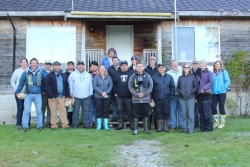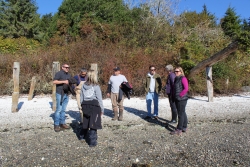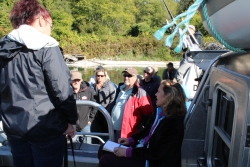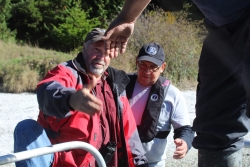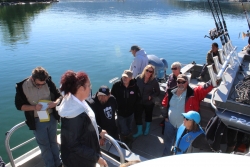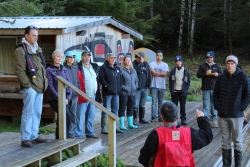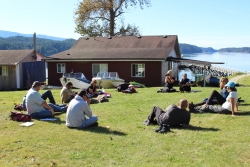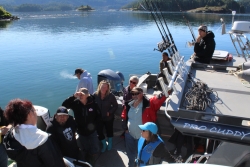Ha-ma-yas First Nations host a field trip for visitors into the territories to see what’s happening on the ground.
“When you see for yourself what it is you and everyone else is working for, it switches on the light,” observes Mamalilikulla Chief Richard Sumner. “There’s no better way to achieve that. Being out there physically—seeing first-hand what you’ve heard about but only imagined—it really brings the stories home in a good way. Even now I still get blown away by what is being seen and discovered here when I get the chance to come out like this.”
Making paper objectives real
It isn’t difficult to get the idea of the Guardian Watchmen. Even on paper the objectives of having Guardians out on the water in the territories of the First Nations are just common sense, and easy to understand: as the “ears and eyes” of the First Nations, they patrol the region to help protect the special places and pristine environments of islands, ocean, flora and fauna within their stewardship responsibilities. They monitor ecosystems, collect data, protect cultural sites, help educate the public and promote compliance with rules for environmental protection and safety.
But nothing brings those concepts to life like seeing them in practice. That’s especially important for the people that the Guardians work with: everyone from provincial government officials to archaeologists and economic development experts, businesses who depend on the region for their various activities, such as kayak guiding and lodges, and not least of all, the public who enjoy the glorious scenery and special places that make the waters and islands around northern Vancouver Island so important to care for and protect.
That’s why, in October 2017, Chief Richard Sumner of the Mamalilikulla Nation hosted a two-day field trip guided by Mamalilikulla, K’omoks, Tlowitsis and Da’naxda’xw Awaetlala First Nations Guardians. The guests included provincial government staff from the Ministry for Indigenous Relations and Reconciliation and the British Columbia Archaeology Branch, archaeological and economic development consultants, and representatives from the Marine Plan Partnership (MaPP) and Nanwakolas Council.
The 2015 North Vancouver Island Marine Plan, developed collaboratively by First Nations and provincial government officials within MaPP, helps guide marine management in the region. Implementation of the MaPP Plan is an ongoing work in progress for everyone involved. But the plan alone isn’t enough, says Barbara Dinning, former MaPP North Vancouver Island Marine Plan Coordinator and now a marine planner and GIS analyst for Nanwakolas Council. “You can read a million words on paper but it isn’t the same as being out there on the water yourself,” says Dinning. “These are the people who make the decisions about many things that happen out there, so it’s important that they see and understand how their decisions have real impacts for the territories and the First Nations who take care of them.”
Getting up close and personal
The first day of the field trip focussed on understanding the impact of tourism and other activities on precious archaeological sites on various islands near Port Neville and Sayward on northern Vancouver Island and in the Broughton Archipelago.
On the one hand, the visitors were told, with assistance from and training by archaeological consultants, the Guardian Watchmen are discovering more and more ancient burial sites, middens and culturally modified trees and sites in the region. That’s exciting. What’s distressing, however, is the extent of vandalism to those sites, especially in recent decades. Signs prohibiting access to burial sites are ignored, or even attract visitors. On some islands, cinder block burial boxes have had to be installed to protect human remains. Over the past fifty years, it is estimated that hundreds of original cedar burial boxes and bones have been stolen as souvenirs.
“That really hit home for me when Mamalilikulla Guardian Darren Puglas spoke about growing up here and spending time with his parents on the islands,” says Dinning. “He talked about how everyone knew that these islands and sites were to be respected and left alone. He’s young but all that has changed just in his lifetime—this is recent desecration, not ancient history. It really emphasizes how important it is to educate people and change that mind-set.”
Economic opportunities
Visitors also were given the opportunity to see Tlowitsis’ shellfish aquaculture pilot project at Port Neville. In the NVI Marine Plan, shellfish aquaculture is identified as having considerable interest and potential for revenue generation, given suitable habitat and available workers with transferable skills. But the plan also identifies challenges to shellfish aquaculture potential, including water temperature, slow tenure processes, the turnover of undeveloped tenures, economies of scale, and a lack of infrastructure, investors, and marketing capacity among other things. To assess that in practice Tlowitsis have begun a shellfish aquaculture pilot project, growing blue mussels, scallops and oysters for two years to determine their viability for commercial development.
Day two of the visit was about Aboriginal tourism potential, a vital aspect of the vision for First Nations in the territories. “On Compton Island, I asked the visitors if they could envision a lodge in this amazing place,” says Chief Sumner. “I have this dream of seeing a beautiful longhouse-style lodge here. Location, location, location, as they say and we have the perfect location to bring people here to enjoy. It’s a huge opportunity for our people to benefit from development of our territory in a good, sustainable way that at the same time provides opportunities for employment and training, a way to help educate people about us and our territory, and just a beautiful experience for visitors.”
A satisfying experience
The field trip was a chance for everyone to talk about the issues and brainstorm ideas together. “I believe everyone took away from the trip how incredibly important it is for the decision-makers to see and hear first-hand from the First Nations how they see these sites, and the need for a better and more collaborative approach,” says Dinning.
Provincial official Andy Witt, the BC government’s co-lead for the MaPP North Vancouver Island process, told MaPP afterwards: “It was a great opportunity to explore this amazing landscape and meet the people who live, work and play there. Having them share their passion and vision with us really helped to gain perspective on the responsibilities and opportunities that come with implementing the marine plan for the area.”
“I think the visitors really got it 100 percent,” concludes Barbara Dinning. “It was very meaningful for them, especially provincial government people. They left saying, ‘Let’s do this.” That is fantastic.”

